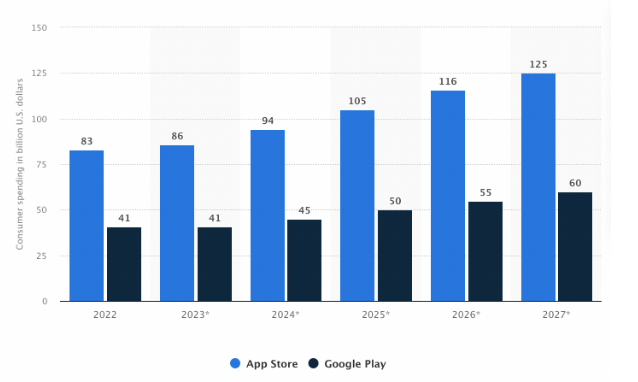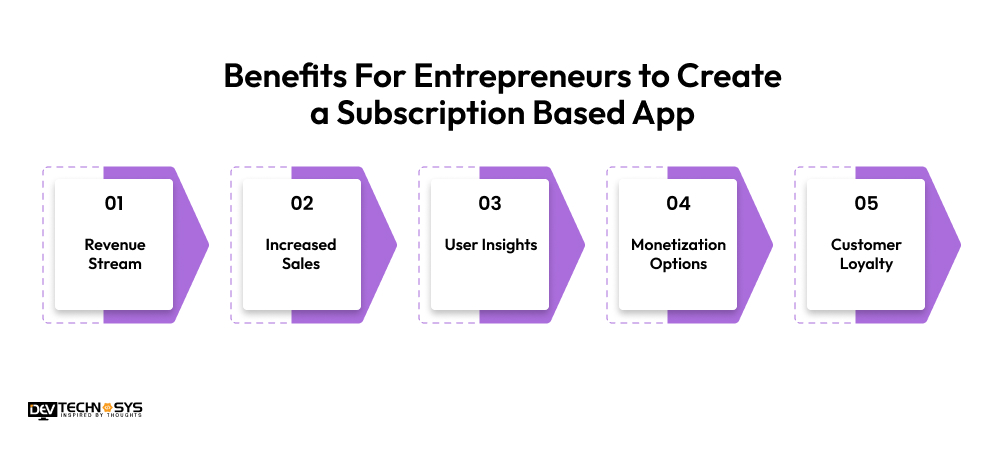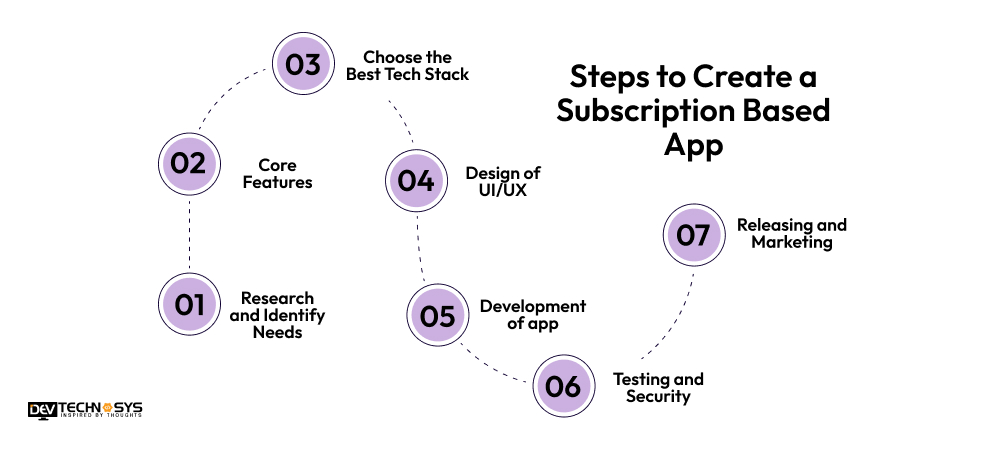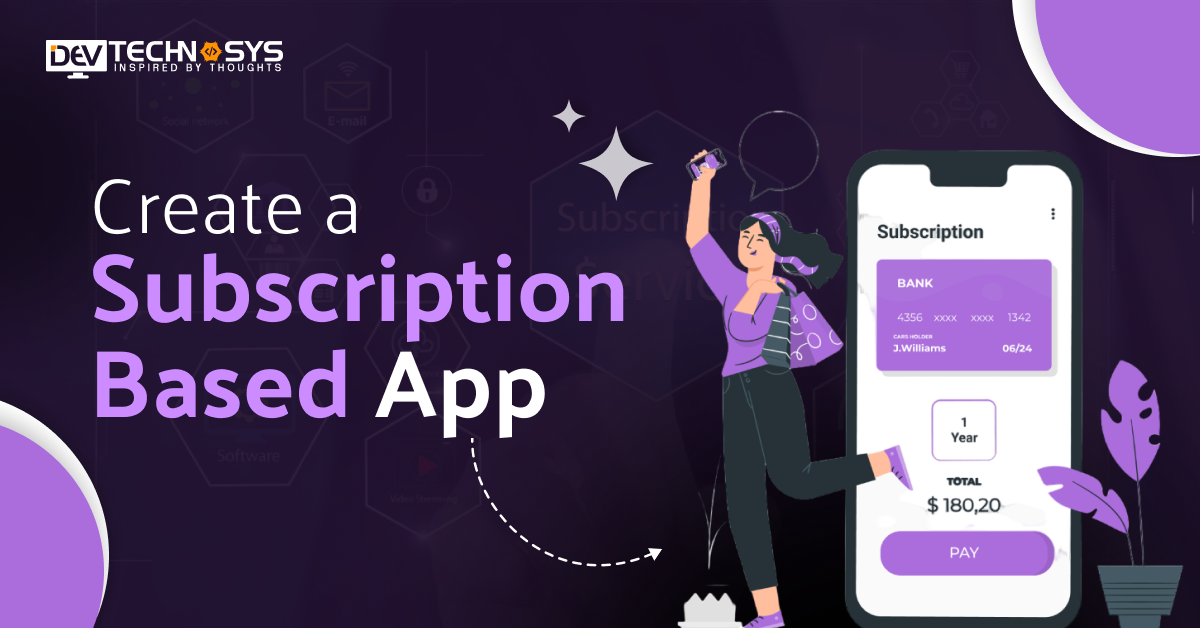“Subscription-based model”
Most successful apps, such as Netflix, Amazon Prime, Apple Music, and Spotify, use a subscription-based model to generate revenue streams and grow rapidly. These apps are globally famous and earn profitable margins in a huge number of transactions.
According to a survey, the subscription-based app market was valued at $650 billion in 2020 and is projected to increase to around $1.5 trillion by the end of 2025.
The above data shows that investing in a subscription-based app is a golden opportunity for entrepreneurs to transform their mobile apps into profitable businesses.
In this blog, we will explore how to create a subscription-based app with unique functionalities and services and how to generate new revenue streams to gain profitable opportunities.
Get started!
Quick Summary: In this blog, we will explore different stages of how to create a subscription based app and top existing subscription-based apps. We also provide robust development stages, benefits, cost of overall development, and successful monetization techniques.
What is a Subscription Based App?
A subscription-based app allows users to access premium or additional services by purchasing subscription plans, such as premium and enterprise. Users can buy the subscription plan monthly or yearly, and they can also purchase the plans weekly or quarterly.
These subscription plans offer different types of purchasing tiers, and users can choose their plans according to their requirements. If you want to make a subscription website, contact an Android app development company to provide successful subscription-based apps.
- The subscription-based app provides secure and multiple payment options such as UPI, net banking, credit or debit cards, and net banking.
- It provides a freemium model, allowing users to access the app’s basic functionality before buying the paid subscription plans.
- This platform enhances the user experience by providing ad-free content and a higher user engagement rate.
- It allows users to download the premium content of the higher quality in a huge data storage area.
Market Analysis of Subscription Based App
- According to the global market, the subscription-based app market was valued at$650 billion in 2020 and is projected to increase to around $1.5 trillion by the end of 2025.
- According to a survey, the average yearly subscription price is $37.51, the weekly subscription average price is$5.97, and the monthly average price is $8.97.
- The subscription-based revenue of media and digital content is projected to grow around 5%between 2021 and 2025.
- According to the reports, the average retention rate for subscription mobile apps is 35% after 90
- According to the global market, mobile gaming apps have the most subscription apps, with 30%of gaming apps being based.

5 Benefits For Entrepreneurs to Create a Subscription Based App
In this modern era, people want to watch premium or exclusive content, and they have to buy subscription plans to access all premium content. Investing in subscription-based business app development services is a profitable opportunity to expand their businesses in a new way. So, here we provide the benefits of the subscription model for entrepreneurs:

1. Revenue Stream
In this first benefit, a subscription-based app provides new revenue streams for businesses and allows users to buy subscription plans to unlock the app’s full potential. These apps can attract more customers by allowing them to subscribe to the app and access all its features and services without any interruption.
2. Increased Sales
This second benefit is that a subscription-based app can motivate users to use it, and its unique features can make it a good choice in this competitive market of relevant industries.
These functionalities can increase businesses’ overall sales and valuation. Offering the cost-effective price of subscription plans can rapidly increase the user base and sales.
3. User Insights
Let’s come to the third benefit: A subscription-based app can observe customers’ or users’ behaviors, habits, purchasing patterns, demographics, favorite services, and more.
According to the radio app development company, these valuable user data insights allow businesses to improve the quality of their services or products and identify new areas for improvement.
4. Monetization Options
In this fourth benefit, subscription-based apps can provide the best monetization options and allow businesses to increase their company’s valuations and enhance market reach globally. These options include a wide variety of additional features, in-app purchases, different pricing tiers, advertising, exclusive content, and more.
5. Customer Loyalty
Let’s move to the last benefit. A subscription-based app offers a long-term subscription with a clear list of additional features and services. It also provides regular updates and sends alerts when new content is uploaded. So, these factors can increase customer loyalty and establish a reputed position in this competitive industry market.
We previously worked with Dev Technosys, which delivered terrific results. We wanted to create a subscription based app and reach Dev Technosys. They have 14+ years of experience in creating acceptable websites or apps. I highly recommend Dev Technosys as it delivers apps or websites within a time and budget, giving us outstanding results.
Maron Bill
7 Key Steps to Create a Subscription Based App
To create a subscription based app, follow the robust development stages to understand every step for a successful app development. Use the latest programming languages to handle highly automated operations and functions. So, here we provide the key steps to create a subscription based app:

1. Research and Identify Needs
In the first stage of development, observe popular or existing subscription-based apps to understand their services and functionalities and implement them in your subscription-based app. Identify your project’s needs and requirements, make a list of the requirements for reducing data redundancy, and identify your app’s ideal or primary users.
2. Core Features
In the second stage of development, hire dedicated developers to identify your project’s core or essential features that should be installed in your subscription-based app. Observe the existing app features and what types of features are trending. It includes many advanced features such as user profiles, online payment options, and more.
3. Choose the Best Tech Stack
Let’s move to the third stage of development: selecting the right tech stack for a successful subscription-based app with extensive functionality and services.
Identify similar app tech stacks and use the cost-effective tech stacks to develop an app within a cost-effective budget. It includes many advanced tech stacks like programming languages, deployment platforms, storage, and APIs.
4. Design of UI/UX
In this fourth stage of development, hire mobile app developers to design a simple user-interface that allows users to easily interact with all features and functions of the app with just one tap.
Designing phase includes many advanced design resources such as inbuilt plugins, layouts, premium themes, menubars, dashboards, and admin panels.
5. Development of App
Let’s move to the development stage, where we assemble a highly professional development team to create a subscription-based subscription-based app with premium functionalities.
This stage is one of the most crucial stages of the development cycle because it involves many implementation phases. It includes many integrated modes, modules, classes, objects, services, etc.
6. Testing and Security
In this sixth stage of development, hire mobile app developers from an Android or iOS app development company to test your subscription-based app under different circumstances.
Scans for the errors or glitches can automatically generated during the implementation phase. After the testing, it’s time for security measurements to ensure that third parties can’t access your app unauthorizedly.
7. Releasing and Marketing
Let’s move to the last stage of development. It’s time to launch your subscription-based app on selected platforms such as Android and iOS. This stage includes many crucial phases that must ensure that all integrated modes are successfully implemented in the app. After publishing, it’s time for marketing, which includes sharing it on social media platforms, product marketing, and email marketing.
10 Must-Have Features to Create a Subscription Based App
For easily access the app’s services, you must understand the features of the subscription-based app. Consider the following significant features for your on demand app development solutions:

1. Subscription Plans
The subscription-based app offers multiple subscription plans, including basic, premium, and enterprise.
2. User Registration
It allows users to create free accounts using their mobile numbers, emails, social media platforms, and guests.
3. Secure Payment Options
This platform provides multiple online payment options, such as credit or debit cards, UPI, net banking, digital wallets, and bank transfer.
4. User-Friendly Interface
The subscription-based app has a user-friendly interface that allows users to easily access all its services and features with just one tap.
5. Social Sharing
This platform allows users to share content on social media, which can increase its popularity and attract new users globally.
6. Offline Access
It allows users to download their favorite content for offline accessibility. To install this feature in your app, contact to an Android app development services provider.
7. Push Notifications
This platform sends the alert message to users, when the new content is uploaded, payment remainder notifications, and daily updates.
8. Multi-Device Accessibility
This allows users to access their accounts on multiple devices seamlessly, enhancing the user experience and convenience.
9. Help Center
If users have any issues with the app, user support is available 24/7 via chat, email, and call to solve the problem as soon as possible.
10. Security Features
The subscription-based app provides robust security measurements such as two-factor authentication, encryption, and compliance.
The Cost to Create a Subscription Based App
The cost to develop a mobile app subscription-based depends on various factors such as features, functions, size, complexity, requirements, and infrastructure. The average cost to create a subscription-based app is around $8,000 to $25,000. So, here we provide the cost chart for a detailed explanation:
Subscription Based App Development |
Estimated Cost |
Time Frame |
|
Simple App Development |
$8000 – $12000 | 2 to 4 Months |
|
Mid-Complex App Development |
$12000 – $20000 | 4 to 6 Months |
|
High-Complex App Development |
$25000+ | 8+ Months |
Tech Stack to Create a Subscription Based App
To build a subscription based app, choose the best tech stack for a successful app development with robust functionalities and services. So, here we provide the list of the tech stacks:
Category |
Tech Stack |
Description |
|
Frontend |
Javascript, CSS, HTML | These powerful platforms build robust user interfaces. |
| Backend | Python, Java | Powerful backend frameworks build robust applications. |
| Database | MYSQL, SQL | Securely stored massive data and organized structured data. |
|
APIs |
REST, GraphQL | Sharing data between applications, systems, and devices. |
|
Authentication |
OAuth, JWT | Verifies the user’s identity and access token from a trusted server. |
|
Cloud Services |
Microsoft Azure, AWS | Allowing apps to access resources in the cloud. |
Why is Post-Launch Support Vital for Your Subscription Based App’s Success?
Post-launch support is one of the most essential stages for your subscription-based app. It includes fixing bugs or errors and providing regular updates. It allows businesses to collect the user feedback and reviews for identifying the new areas for improvement.
Providing regular maintenance and support can enhance the long-term relationships with users and it can also increase the user loyalty and user base.
How Dev Technosys Will Help You?
In this blog, we discussed in depth how to build a subscription based website and how it can be more beneficial for businesses. We hope that you have clarified all your doubts regarding how to create a subscription website with unique functionalities.
It includes many benefits for the business, such as higher success rates, global reach, and enhanced user engagement.
Dev Technosys is a leading mobile app development company that provides efficient or reliable mobile apps with a cost-effective budget and time.
Frequently Asked Questions
1. How Much Does it Cost to Create a Subscription Based App?
Subscription based mobile app development cost is around $8,000 to $25,000, depending on project’s complexity, features, functions, and size.
2. What are the Key Features of the Subscription Based App?
Here we provide the list of the core features of the subscription-based app:
- Online payment options
- User profile
- Offline access
- Social sharing
3. How Long Does it Take to Create a Subscription Based App?
To make a subscription based app, it mainly takes around 4 to 8 months of overall development, depending on the project requirements.
4. Why do Businesses Invest in Subscription Based App Development?
We provide the list of benefits for the businesses:
- Scalability
- Globally reached
- Enhance brand visibility
- Increased sales
5. Which Technologies Are Used to Create a Subscription Based App?
Popular technologies are used to create a subscription-based app:
- Java
- Python
- PHP
- Flutter















